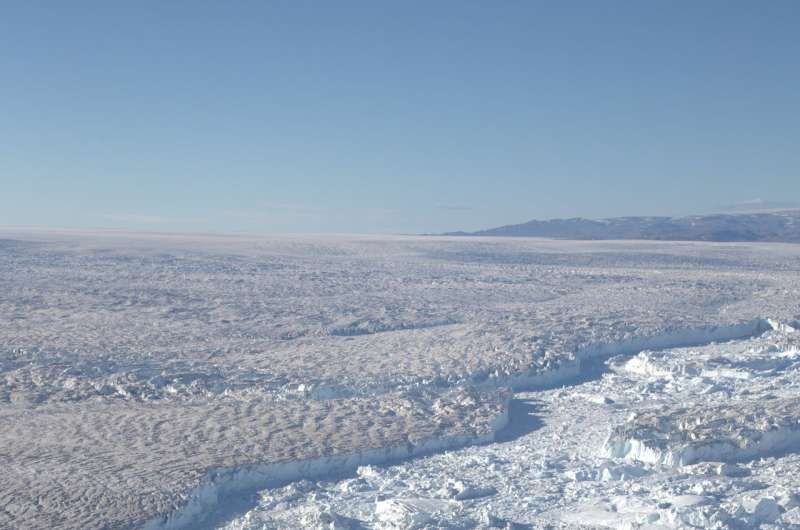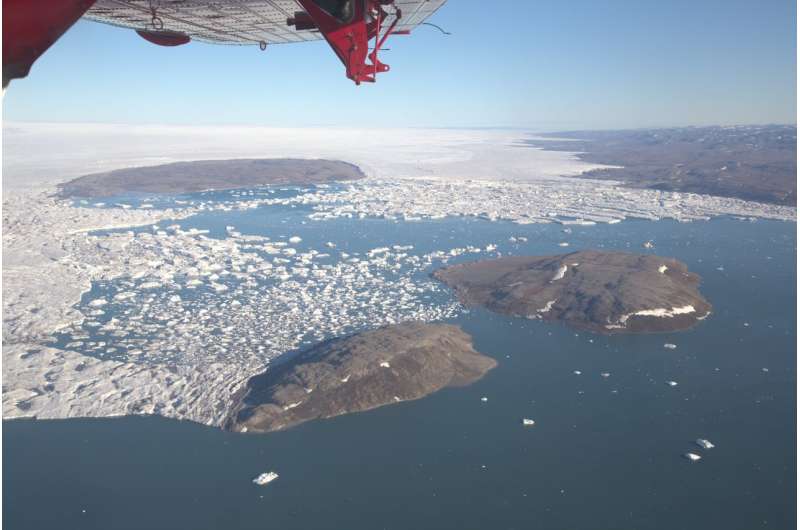Ice stream draining Greenland Ice Sheet sensitive to changes over past 45,000 years

A ribbon of ice more than 600 kilometers long that drains about 12 percent of the gigantic Greenland Ice Sheet has been smaller than it is today about half of the time over the past 45,000 years, a new study suggests.
Interestingly, the loss of ice from the Northeast Greenland Ice Stream (NEGIS) took place not only during the warm Holocene period, but also during a period thought to be very cold preceding the last glacial maximum, the researchers say.
The findings suggest that NEGIS is particularly sensitive to environmental changes, which may exacerbate the influence of anthropogenic climate change. Results of the study are being published today in Nature Communications.
"There are some parts of the ice sheet that are relatively stable and others that show evidence of very rapid retreating—a pattern we're seeing today as well as thousands of years ago," said Anders Carlson, an Oregon State University geologist and co-author on the study. "Some of it relates to bed topography—when the bed is below sea level, it stabilizes that part of the ice sheet. In low spots, it is unstable."
Carlson said different factors may help explain the ice mass loss, including orbital forcing and warm summer temperatures. The path of the Earth's orbit put it closer to the sun some 9,000 years ago, breaking the planet out of its glacial maximum. NEGIS showed significant ice loss.

Yet it also showed a loss of ice during the period preceding that maximum, about 41,000 to 26,000 years ago, which is thought to have been very cold. OSU paleoclimatologist Christo Buizert, also a co-author on the study, reconstructed air temperatures from that period using ice core analysis and found that air temperatures indeed were much colder than average, but summer temperatures were warmer, which may have contributed to the ice loss.
"That period was also quite dry and there wasn't nearly as much snowfall," Carlson said, "which may have driven the ice margin to be smaller."
The researchers were able to determine where the ice sheet margins were essentially by analyzing the rocks for "sunburn," Carlson said. When ice has retreated, the rocks become exposed to cosmic rays that hit the quartz in the rock and split the elements, creating beryllium-10. This cosmic bombardment leaves an elemental fingerprint that allows the researchers to reconstruct ice-free times over thousands of years.
"The anthropogenic forcing we are seeing today is having a significant impact on the ice sheet and it already has retreated to levels that weren't predicted to occur until the end of the century," Carlson said.
A team of Danish and American researchers conducted much of the fieldwork, studying three fast-flowing marine-terminating "outlet" glaciers on the Greenland Ice Sheet.
"Modern observations have shown that the NEGIS is very susceptible to changes in both air and ocean temperatures and is presently in a phase of rapid ice retreat," said Nicolaj Larsen of Aarhus University in Denmark, lead author on the study. Larsen spent much of the past year on sabbatical at Oregon State, where he collaborated with the OSU researchers.
Journal information: Nature Communications
Provided by Oregon State University




















